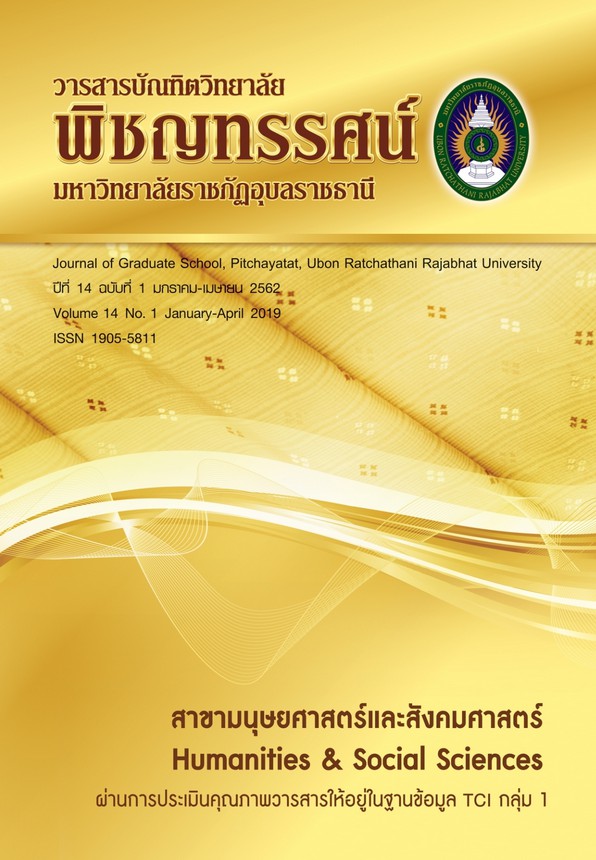การพัฒนาชุดการสอน เรื่อง จำนวนจริง เพื่อพัฒนาทักษะและกระบวนการทางคณิตศาสตร์ด้วยกระบวนการ MIAP สำหรับนักเรียนชั้นมัธยมศึกษาปีที่ 4
คำสำคัญ:
กระบวนการ MIAP, จำนวนจริง, ทักษะและกระบวนการทางคณิตศาสตร์บทคัดย่อ
การวิจัยครั้งนี้มีวัตถุประสงค์ 1) เพื่อพัฒนาชุดการสอน เรื่อง จำนวนจริง เพื่อพัฒนาทักษะและกระบวนการทางคณิตศาสตร์ ด้วยกระบวนการ MIAP สำหรับนักเรียนชั้นมัธยมศึกษาปีที่ 4 ให้มีประสิทธิภาพตามเกณฑ์ 75/75 2) เพื่อศึกษาทักษะและกระบวนการทางคณิตศาสตร์หลังการใช้ชุดการสอน เรื่อง จำนวนจริง ด้วยกระบวนการ MIAP สำหรับนักเรียนชั้นมัธยมศึกษาปีที่ 4 และ 3) เพื่อศึกษาผลสัมฤทธิ์ทางการเรียนของนักเรียนชั้นมัธยมศึกษาปีที่ 4 หลังจากได้รับการจัดกิจกรรมการเรียนการสอนโดยใช้ชุดการสอน เรื่อง จำนวนจริง เพื่อพัฒนาทักษะและกระบวนการทางคณิตศาสตร์ด้วยกระบวนการ MIAP กับเกณฑ์ร้อยละ 75 กลุ่มตัวอย่างที่ใช้เป็นนักเรียนชั้นมัธยมศึกษาปีที่ 4 โรงเรียนจรัสพิชากร ภาคเรียนที่ 2 ปีการศึกษา 2559 จำนวน 33 คน ได้มาจากการสุ่มแบบกลุ่ม โดยมีห้องเรียนเป็นหน่วยสุ่ม เครื่องมือที่ใช้ในการวิจัยประกอบด้วย ชุดการสอนด้วยกระบวนการ MIAP เรื่อง จำนวนจริง แบบทดสอบประจำชุดการสอน แบบทดสอบวัดผลสัมฤทธิ์ทางการเรียนแบบปรนัยชนิดเลือกตอบมี 4 ตัวเลือก จำนวน 30 ข้อ มีค่าความเชื่อมั่นเท่ากับ 0.71 แบบทดสอบวัดทักษะและกระบวนการทางคณิตศาสตร์แบบอัตนัย จำนวน 4 ข้อ ค่าความเชื่อมั่นเท่ากับ 0.73 สถิติที่ใช้ในการวิเคราะห์ข้อมูลคือ ค่าเฉลี่ยเลขคณิต ส่วนเบี่ยงเบนมาตรฐาน และทดสอบสมมติฐานโดยใช้การทดสอบที ผลการวิจัยพบว่า 1) ประสิทธิภาพของชุดการสอน เรื่อง จำนวนจริง เพื่อพัฒนาทักษะและกระบวนการทางคณิตศาสตร์ด้วยกระบวนการ MIAP สำหรับนักเรียนชั้นมัธยมศึกษาปีที่ 4 มีประสิทธิภาพเท่ากับ 78.79/77.13 ซึ่งสูงกว่าเกณฑ์ 2) ทักษะและกระบวนการทางคณิตศาสตร์ ของนักเรียนชั้นมัธยมศึกษาปีที่ 4 หลังได้รับการจัดกิจกรรมการเรียนการสอน ปรากฏว่ามีคะแนนสูงกว่าเกณฑ์ร้อยละ 70 อย่างมีนัยสำคัญทางสถิติที่ระดับ 0.05 3) ผลสัมฤทธิ์ทางการเรียนของนักเรียนชั้นมัธยมศึกษาปีที่ 4 หลังได้รับการจัดกิจกรรมการเรียนการสอน ปรากฏว่าคะแนนของผลสัมฤทธิ์หลังการเรียนสูงกว่าเกณฑ์ร้อยละ 75 อย่างมีนัยสำคัญทางสถิติที่ระดับ 0.05
เอกสารอ้างอิง
ชูเกียรติ จับเทียน. การพัฒนาชุดกิจกรรมที่สร้างตามกระบวนการ MIAP เรื่อง เลขยกกำลัง สำหรับนักเรียนระดับประกาศนียบัตรวิชาชีพ. วิทยานิพนธ์การศึกษามหาบัณฑิต มหาวิทยาลัยนเรศวร, 2558.
ญาณกวี ขัดสีทะสี. การจัดการเรียนรู้ด้วยเทคนิคเคดับเบิ้ลยูดีแอลเพื่อส่งเสริมทักษะการแก้ปัญหาและการให้เหตุผลทางคณิตศาสตร์ สำหรับนักเรียนชั้นมัธยมศึกษาปีที่ 3 โรงเรียนบ้านปง จังหวัดเชียงใหม่. วิทยานิพนธ์ศึกษาศาสตรมหาบัณฑิต มหาวิทยาลัยเชียงใหม่, 2557.
ณัฐกฤษ จันทร์ตะ. การพัฒนาชุดการสอนคณิตศาสตร์ที่เน้นกระบวนการแก้ปัญหา เรื่อง ความน่าจะเป็น สำหรับนักเรียนชั้นมัธยมศึกษาปีที่ 3. วิทยานิพนธ์ครุศาสตรมหาบัณฑิต สถาบันราชภัฏนครสวรรค์, 2546.
บุญเกื้อ ควรหาเวช. นวัตกรรมการศึกษา. พิมพ์ครั้งที่ 4. กรุงเทพฯ: ศูนย์หนังสือจุฬาลงกรณ์มหาวิทยาลัย, 2542.
ศึกษาธิการ, กระทรวง. หลักสูตรแกนกลางการศึกษาขั้นพื้นฐาน พุทธศักราช 2551. กรุงเทพฯ: โรงพิมพ์คุรุสภาลาดพร้าว, 2551.
ส่งเสริมการสอนวิทยาศาสตร์และเทคโนโลยี, สถาบัน. หนังสือเรียนสาระการเรียนรู้พื้นฐานคณิตศาสตร์ เล่ม 1 ชั้นมัธยมศึกษาปีที่ 4. กรุงเทพฯ: โรงพิมพ์คุรุสภาลาดพร้าว, 2551.
สุชาติ ศิริสุขไพบูลย์. เทคนิคและวิธีการสอนวิชาชีพ MIAP. กรุงเทพฯ: โรงพิมพ์สถาบันเทคโนโลยีพระจอมเกล้าพระนครเหนือ, 2549.
สุราษฎร์ พรมจันทร์. การพัฒนาหลักสูตรรายวิชา Course Development. พิมพ์ครั้งที่ 2. กรุงเทพฯ: ภาควิชาครุศาสตร์เครื่องกล คณะครุศาสตร์อุตสาหกรรม สถาบันเทคโนโลยีพระจอมเกล้า พระนครเหนือ, 2552.
อัครวุฒิ จินดานุรักษ์. การพัฒนารูปแบบการสอนคณิตศาสตร์ด้วยกระบวนการ MIAP. วิทยานิพนธ์ครุศาสตร์อุตสาหกรรม ดุษฎีบัณฑิต มหาวิทยาลัยเทคโนโลยีพระจอมเกล้า พระนครเหนือ, 2553.
National Council of Teachers of Mathematics (NCTM). Principles and Standards for Mathematics. Reston, Va: NCTM, 2000.
ดาวน์โหลด
เผยแพร่แล้ว
รูปแบบการอ้างอิง
ฉบับ
ประเภทบทความ
สัญญาอนุญาต
บทความทุกเรื่องได้รับการตรวจความถูกต้องทางวิชาการโดยผู้ทรงคุณวุฒิภายนอกอย่างน้อย 2 คน ความคิดเห็นในวารสารบัณฑิตวิทยาลัย พิชญทรรศน์ มหาวิทยาลัยราชภัฏอุบลราชธานี เป็นความคิดเห็นของผู้เขียนมิใช่ความคิดเห็นของผู้จัดทำ จึงมิใช่ ความรับผิดชอบของบัณฑิตวิทยาลัย มหาวิทยาลัยราชภัฏอุบลราชธานี และบทความในวารสารบัณฑิตวิทยาลัย พิชญทรรศน์ มหาวิทยาลัยราชภัฏอุบลราชธานี สงวนสิทธิ์ตามกฎหมายไทย การจะนำไปเผยแพร่ต้องได้รับอนุญาตเป็นลายลักษณ์อักษรจากกองบรรณาธิการ






